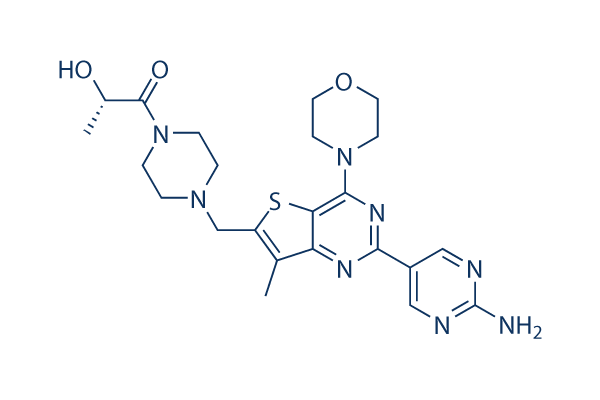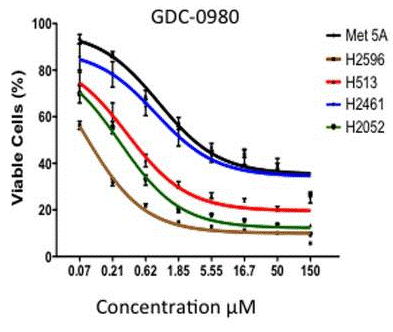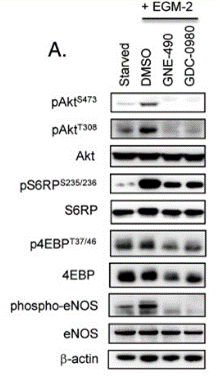
- Inhibitors
- By product type
- Natural Products
- Inducing Agents
- Peptides
- Antibiotics
- Antibody-drug Conjugates(ADC)
- PROTAC
- Hydrotropic Agents
- Dyes
- By Signaling Pathways
- PI3K/Akt/mTOR
- Epigenetics
- Methylation
- Immunology & Inflammation
- Protein Tyrosine Kinase
- Angiogenesis
- Apoptosis
- Autophagy
By research - Antibodies
- Compound Libraries
- Popular Compound Libraries
- Customize Library
- Clinical and FDA-approved Related
- Bioactive Compound Libraries
- Inhibitor Related
- Natural Product Related
- Metabolism Related
- Cell Death Related
- By Signaling Pathway
- By Disease
- Anti-infection and Antiviral Related
- Neuronal and Immunology Related
- Fragment and Covalent Related
- FDA-approved Drug Library
- FDA-approved & Passed Phase I Drug Library
- Preclinical/Clinical Compound Library
- Bioactive Compound Library-I
- Bioactive Compound Library-Ⅱ
- Kinase Inhibitor Library
- Express-Pick Library
- Natural Product Library
- Human Endogenous Metabolite Compound Library
- Alkaloid Compound LibraryNew
- Angiogenesis Related compound Library
- Anti-Aging Compound Library
- Anti-alzheimer Disease Compound Library
- Antibiotics compound Library
- Anti-cancer Compound Library
- Anti-cancer Compound Library-Ⅱ
- Anti-cancer Metabolism Compound Library
- Anti-Cardiovascular Disease Compound Library
- Anti-diabetic Compound Library
- Anti-infection Compound Library
- Antioxidant Compound Library
- Anti-parasitic Compound Library
- Antiviral Compound Library
- Apoptosis Compound Library
- Autophagy Compound Library
- Calcium Channel Blocker LibraryNew
- Cambridge Cancer Compound Library
- Carbohydrate Metabolism Compound LibraryNew
- Cell Cycle compound library
- CNS-Penetrant Compound Library
- Covalent Inhibitor Library
- Cytokine Inhibitor LibraryNew
- Cytoskeletal Signaling Pathway Compound Library
- DNA Damage/DNA Repair compound Library
- Drug-like Compound Library
- Endoplasmic Reticulum Stress Compound Library
- Epigenetics Compound Library
- Exosome Secretion Related Compound LibraryNew
- FDA-approved Anticancer Drug LibraryNew
- Ferroptosis Compound Library
- Flavonoid Compound Library
- Fragment Library
- Glutamine Metabolism Compound Library
- Glycolysis Compound Library
- GPCR Compound Library
- Gut Microbial Metabolite Library
- HIF-1 Signaling Pathway Compound Library
- Highly Selective Inhibitor Library
- Histone modification compound library
- HTS Library for Drug Discovery
- Human Hormone Related Compound LibraryNew
- Human Transcription Factor Compound LibraryNew
- Immunology/Inflammation Compound Library
- Inhibitor Library
- Ion Channel Ligand Library
- JAK/STAT compound library
- Lipid Metabolism Compound LibraryNew
- Macrocyclic Compound Library
- MAPK Inhibitor Library
- Medicine Food Homology Compound Library
- Metabolism Compound Library
- Methylation Compound Library
- Mouse Metabolite Compound LibraryNew
- Natural Organic Compound Library
- Neuronal Signaling Compound Library
- NF-κB Signaling Compound Library
- Nucleoside Analogue Library
- Obesity Compound Library
- Oxidative Stress Compound LibraryNew
- Plant Extract Library
- Phenotypic Screening Library
- PI3K/Akt Inhibitor Library
- Protease Inhibitor Library
- Protein-protein Interaction Inhibitor Library
- Pyroptosis Compound Library
- Small Molecule Immuno-Oncology Compound Library
- Mitochondria-Targeted Compound LibraryNew
- Stem Cell Differentiation Compound LibraryNew
- Stem Cell Signaling Compound Library
- Natural Phenol Compound LibraryNew
- Natural Terpenoid Compound LibraryNew
- TGF-beta/Smad compound library
- Traditional Chinese Medicine Library
- Tyrosine Kinase Inhibitor Library
- Ubiquitination Compound Library
-
Cherry Picking
You can personalize your library with chemicals from within Selleck's inventory. Build the right library for your research endeavors by choosing from compounds in all of our available libraries.
Please contact us at info@selleckchem.com to customize your library.
You could select:
- Bioreagents
- qPCR
- 2x SYBR Green qPCR Master Mix
- 2x SYBR Green qPCR Master Mix(Low ROX)
- 2x SYBR Green qPCR Master Mix(High ROX)
- Protein Assay
- Protein A/G Magnetic Beads for IP
- Anti-Flag magnetic beads
- Anti-Flag Affinity Gel
- Anti-Myc magnetic beads
- Anti-HA magnetic beads
- Poly DYKDDDDK Tag Peptide lyophilized powder
- Protease Inhibitor Cocktail
- Protease Inhibitor Cocktail (EDTA-Free, 100X in DMSO)
- Phosphatase Inhibitor Cocktail (2 Tubes, 100X)
- Cell Biology
- Cell Counting Kit-8 (CCK-8)
- Animal Experiment
- Mouse Direct PCR Kit (For Genotyping)
- Featured Products
- MRTX1133
- Nab-Paclitaxel
- KP-457
- IAG933
- RMC-6236 (Daraxonrasib)
- RMC-7977
- Zoldonrasib (RMC-9805)
- GsMTx4
- Navitoclax (ABT-263)
- TSA (Trichostatin A)
- Y-27632 Dihydrochloride
- SB431542
- SB202190
- MK-2206 Dihydrochloride
- LY294002
- Alisertib (MLN8237)
- XAV-939
- CHIR-99021 (Laduviglusib)
- Bafilomycin A1 (Baf-A1)
- Thiazovivin (TZV)
- CP-673451
- Verteporfin
- DAPT
- Galunisertib (LY2157299)
- MG132
- SBE-β-CD
- Tween 80
- Bavdegalutamide (ARV-110)
- Z-VAD-FMK
- Wnt-C59 (C59)
- IWR-1-endo
- (+)-JQ1
- 3-Deazaneplanocin A (DZNep) Hydrochloride
- RepSox (E-616452)
- Erastin
- Q-VD-Oph
- Puromycin Dihydrochloride
- Cycloheximide
- Telaglenastat (CB-839)
- A-83-01
- Ceralasertib (AZD6738)
- Liproxstatin-1
- Emricasan (IDN-6556)
- PMA (Phorbol 12-myristate 13-acetate)
- Dibutyryl cAMP (Bucladesine) sodium
- Nedisertib (M3814)
- PLX5622
- IKE (Imidazole Ketone Erastin)
- STM2457
- Saruparib (AZD5305)
- New Products
- Contact Us
research use only
Apitolisib (GDC-0980) PI3K inhibitor
Cat.No.S2696

Chemical Structure
Molecular Weight: 498.6
Quality Control
Batch:
Purity:
99.76%
99.76
Cell Culture, Treatment & Working Concentration
| Cell Lines | Assay Type | Concentration | Incubation Time | Formulation | Activity Description | PMID |
|---|---|---|---|---|---|---|
| insect cells | Function assay | 30 mins | Inhibition of human recombinant mTOR expressed in insect cells assessed as phosphorylation of recombinant (GFP)-4-EBP1 measured after 30 mins by fluorescence polarization assay, Ki=0.017μM | 21981714 | ||
| PC3 | Function assay | Inhibition of PIK3 gamma-mediated Akt phosphorylation at Ser473 in human PC3 cells by ELISA, IC50=0.036μM | 21981714 | |||
| MCF7.1 | Antiproliferative assay | Antiproliferative activity against human MCF7.1 cells expressing HER2 gene after overnight incubation by CellTiter-Glo luminescence assay, IC50=0.255μM | 21981714 | |||
| PC3 | Antiproliferative assay | Antiproliferative activity against human PC3 cells after overnight incubation by CellTiter-Glo luminescence assay, IC50=0.307μM | 21981714 | |||
| PC3 | Antitumor assay | 1 mg/kg | 14 days | Antitumor activity against human PC3 cells xenografted in athymic nu/nu mouse assessed as delay in tumor growth at 1 mg/kg, po qd for 14 days | 21981714 | |
| MCF7-neo | Antitumor assay | 1 mg/kg | 22 days | Antitumor activity against human MCF7-neo cells expressing HER2 gene xenografted in athymic nu/nu mouse assessed as delay in tumor growth at 1 mg/kg, po qd for 22 days | 21981714 | |
| PC3 | Antitumor assay | Antitumor activity against human PC3 cells xenografted in athymic nu/nu mouse assessed as tumor regression at maximum tolerated dose | 21981714 | |||
| MCF7-neo | Antitumor assay | Antitumor activity against human MCF7-neo cells expressing HER2 gene xenografted in athymic nu/nu mouse assessed as tumor regression at maximum tolerated dose | 21981714 | |||
| PC3 | Antitumor assay | 14 days | Antitumor activity against human PC3 cells xenografted in athymic nu/nu mouse assessed as tumor stasis at maximum tolerated dose measured on day 14 | 21981714 | ||
| MCF7-neo | Antitumor assay | 22 days | Antitumor activity against human MCF7-neo cells expressing HER2 gene xenografted in athymic nu/nu mouse assessed as tumor stasis at maximum tolerated dose measured on day 22 | 21981714 | ||
| PC3 | Function assay | 10 mg/kg | 6 hrs | Inhibition of mTORC2 in human PC3 cells xenografted mouse assessed as reduction of phosphorylated Akt level at 10 mg/kg, po after 6 hrs | 23199076 | |
| PC3 | Function assay | 10 mg/kg | 6 hrs | Inhibition of mTORC1 in human PC3 cells xenografted mouse assessed as reduction of phosphorylated p70S6K level at 10 mg/kg, po after 6 hrs | 23199076 | |
| insect cells | Function assay | 30 mins | Inhibition of human recombinant mTOR (1360 to 2549 residues) expressed in insect cells assessed as inhibition of GFP-labeled 4-EBP1 phosphorylation at Thr-37/46 residues incubated for 30 mins by FRET assay, Ki=0.017μM | 27096040 | ||
| PC3 | Antiproliferative assay | 3 days | Antiproliferative activity against human PC3 cells after 3 days by CellTitre-Glo assay, EC50=0.31μM | 27096040 | ||
| VERO-E6 | Toxicity assay | 48 hrs | Toxicity CC50 against VERO-E6 cells determined at 48 hours by high content imaging (same conditions as 2_LEY without exposure to 0.01 MOI SARS CoV-2 virus), CC50=0.5μM | ChEMBL | ||
| VERO-E6 | Function assay | 48 hrs | Determination of IC50 values for inhibition of SARS-CoV-2 induced cytotoxicity of VERO-E6 cells after 48 hours exposure to 0.01 MOI SARS CoV-2 virus by high content imaging, IC50=2.31μM | ChEMBL | ||
| Click to View More Cell Line Experimental Data | ||||||
Chemical Information, Storage & Stability
| Molecular Weight | 498.6 | Formula | C23H30N8O3S |
Storage (From the date of receipt) | |
|---|---|---|---|---|---|
| CAS No. | 1032754-93-0 | Download SDF | Storage of Stock Solutions |
|
|
| Synonyms | RG7422, GNE 390 | Smiles | CC1=C(SC2=C1N=C(N=C2N3CCOCC3)C4=CN=C(N=C4)N)CN5CCN(CC5)C(=O)C(C)O | ||
Solubility
|
In vitro |
DMSO
: 27 mg/mL
(54.15 mM)
Water : Insoluble Ethanol : Insoluble |
Molarity Calculator
|
In vivo |
|||||
In vivo Formulation Calculator (Clear solution)
Step 1: Enter information below (Recommended: An additional animal making an allowance for loss during the experiment)
mg/kg
g
μL
Step 2: Enter the in vivo formulation (This is only the calculator, not formulation. Please contact us first if there is no in vivo formulation at the solubility Section.)
% DMSO
%
% Tween 80
% ddH2O
%DMSO
%
Calculation results:
Working concentration: mg/ml;
Method for preparing DMSO master liquid: mg drug pre-dissolved in μL DMSO ( Master liquid concentration mg/mL, Please contact us first if the concentration exceeds the DMSO solubility of the batch of drug. )
Method for preparing in vivo formulation: Take μL DMSO master liquid, next addμL PEG300, mix and clarify, next addμL Tween 80, mix and clarify, next add μL ddH2O, mix and clarify.
Method for preparing in vivo formulation: Take μL DMSO master liquid, next add μL Corn oil, mix and clarify.
Note: 1. Please make sure the liquid is clear before adding the next solvent.
2. Be sure to add the solvent(s) in order. You must ensure that the solution obtained, in the previous addition, is a clear solution before proceeding to add the next solvent. Physical methods such
as vortex, ultrasound or hot water bath can be used to aid dissolving.
Mechanism of Action
| Features |
A potent, selective, and orally available inhibitor of PI3Kα, β, δ, γ and mTOR.
|
|---|---|
| Targets/IC50/Ki | |
| In vitro |
Apitolisib (GDC-0980) shows potent and selective inhibitory activities against class I PI3K and mTOR kinase versus a large panel of kinases, with Ki of 17 nM for mTOR and IC50 of 5 nM, 27 nM, 7 nM, and 14 nM for PI3Kα, β, δ, and γ, respectively. [1] In vitro, this compound significantly inhibits cell proliferation in PC3 and MCF7 cells with IC50 of 307 nM and 255 nM, respectively. [1] A recent study shows that it reduces cancer cell viability by inhibiting cell-cycle procession and inducing apoptosis with most potency in prostate (IC50 < 200 nM 50%, <500 nM 100%), breast (IC50 <200 nM 37%, <500 nM 78%) and NSCLC lines (IC50 <200 nM 29%, <500 nM 88%) and less potency in pancreatic (IC50 <200 nM 13%, <500 nM 67%) and melanoma cell lines (IC50 <200 nM 0%, <500 nM 33%). [2]
|
| Kinase Assay |
Enzymatic activity
|
|
Apitolisib (GDC-0980) is evaluated through enzymatic activity assays for Class I PI3K isoforms using a fluorescence polarization method that monitors the formation of 3,4,5-inositoltriphosphate, which competes with fluorescently labeled PIP3 for binding to the GRP-1 pleckstrin homology domain protein. An increase in phosphatidyl inositide-3-phosphate product results in a decrease in fluorescence polarization signal as the labeled fluorophore is displaced from the GRP-1 protein binding site. Class I PI3K isoforms are expressed and purified as heterodimeric recombinant proteins. PI3K isoforms are assayed under initial rate conditions in the presence of 10 mM Tris (pH 7.5), 25 μM ATP, 9.75 μM PIP2, 5% glycerol, 4 mM MgCl2, 50 mM NaCl, 0.05% (v/v) Chaps, 1 mM dithiothreitol, 2% (v/v) DMSO at the following concentrations for each isoform: PI3Kα,β at 60 ng/mL; PI3Kγ at 8 ng/mL; PI3Kδ at 45 ng/mL. After assay for 30 minutes at 25°C, reactions are terminated with a final concentration of 9 mM EDTA, 4.5 nM TAMRA-PIP3, and 4.2 μg/mL GRP-1 detector protein before reading fluorescence polarization on an Envision plate reader. IC50s are calculated from the fit of the dose−response curves to a 4-parameter equation. Human recombinant mTOR(1360−2549) is expressed and purified from insect cells and assayed using a Lanthascreen fluorescence resonance energy transfer format in which phosphorylation of recombinant green fluorescent protein (GFP)-4-EBP1 is detected using a terbium-labeled antibody to phospho-threonine 37/46 of 4-EBP1. Reactions are initiated with ATP and conducted in the presence of 50 mM Hepes (pH 7.5), 0.25 nM mTOR, 400 nM GFP-4E-BP1, 8 μM ATP, 0.01% (v/v) Tween 20, 10 mM MnCl2, 1 mM EGTA, 1 mM dithiothreitol, and 1% (v/v) DMSO. Assays are conducted under initial rate conditions at room temperature for 30 minutes before terminating the reaction and detecting product in the presence of 2 nM Tb-anti-p4E-BP1 antibody and 10 mM EDTA. Dose−response curves are fit to an equation for competitive tight-binding inhibition and apparent Ki' s are calculated using the determined Km for ATP of 6.1 μM.
|
|
| In vivo |
Apitolisib (GDC-0980) exhibits significant antitumor activity at a dose of 1 mg/kg by causing tumor growth delay in both PC-3 and MCF-7 neo/HER2 xenograft models. Furthermore, this compound results in tumor stasis or regressions at the maximum tolerated dose of 7.5 mg/kg. [1] In mice, intravenous administration at 1 mg/kg leads to low clearance (Clp: 9.2 mL/min/kg, Vss: 1.7 L/kg). While, oral administration at 5 mg/kg in 80% PEG400 and at 50 mg/kg as a crystalline suspension in 0.5% methylcellulose/0.2% Tween-80 also results in favorable pharmacokinetic parameters. [1]
|
References |
Applications
| Methods | Biomarkers | Images | PMID |
|---|---|---|---|
| Growth inhibition assay | Cell viability |

|
25221930 |
| Western blot | p-AKT / AKT / p-S6RP / S6RP / p-4EBP / 4EBP / p-eNOS / eNOS |

|
23814482 |
Clinical Trial Information
(data from https://clinicaltrials.gov, updated on 2024-05-22)
| NCT Number | Recruitment | Conditions | Sponsor/Collaborators | Start Date | Phases |
|---|---|---|---|---|---|
| NCT01487239 | Completed | Healthy Volunteer |
Genentech Inc. |
December 2011 | Phase 1 |
| NCT01455493 | Completed | Endometrial Carcinoma |
Genentech Inc. |
December 2011 | Phase 2 |
| NCT01442090 | Completed | Renal Cell Carcinoma |
Genentech Inc. |
October 2011 | Phase 2 |
| NCT01254526 | Completed | Breast Cancer |
Genentech Inc. |
December 2010 | Phase 1 |
| NCT00854126 | Completed | Non-Hodgkin''s Lymphoma Solid Cancers |
Genentech Inc. |
May 2009 | Phase 1 |
| NCT00854152 | Completed | Non-Hodgkin''s Lymphoma Solid Cancers |
Genentech Inc. |
March 2009 | Phase 1 |
Tech Support
Tel: +1-832-582-8158 Ext:3
If you have any other enquiries, please leave a message.






































